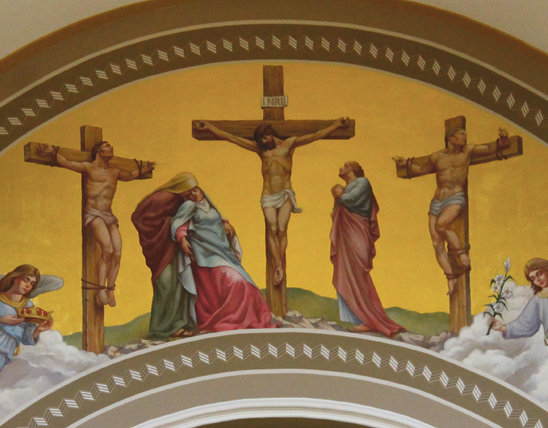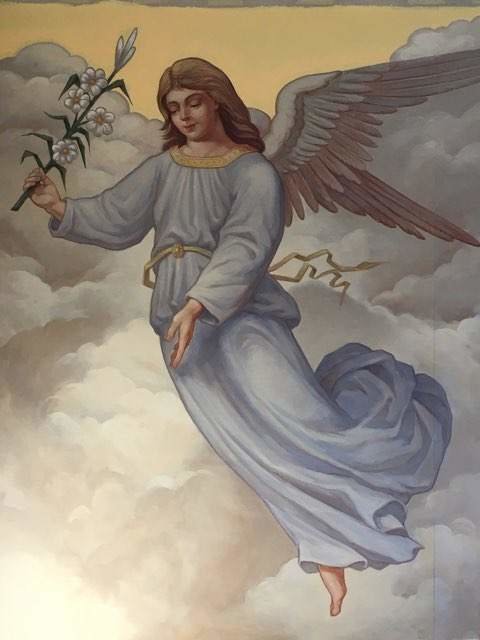New Crucifixion mural in Westphalia highlights Christ’s sacrifice

(Scroll the arrows to see four more images.)
CLICK HERE to see a gallery of photos related to this article.
“No one has greater love than this, to lay down one’s life for one’s friends.” — John 15:13
The most loving gift of all time is rendered in radiant hues, high above the altar of St. Joseph Church in Westphalia.
A newly created Crucifixion mural atop the church’s lofty chancel arch proclaims the perpetual link between the Holy Sacrifice of the Mass and Christ’s eternal Sacrifice on Calvary.
“This is the most profound Catholic setting I have ever seen in a church,” stated Father Anthony Viviano, pastor of St. Joseph parish in Westphalia and St. Anthony of Padua parish in Folk. “The sacred altar, where God mystically meets man at every Mass, is there to receive symbolically the blood of the crucified Jesus, which falls from above.”
The 24-foot-wide mural is one of the capstones of the nearly completed two-year renovation of the inside and outside of St. Joseph Church.
Artist Stoyko Stoykov of Conrad Schmitt Studios created the mural in six pieces in a temporary studio inside a building just down Main Street from the church.
Mr. Stoykov has helped redecorate and restore numerous churches in his nearly four-decade career, but never before had he created a Crucifixion scene quite like this one.
“It doesn’t only include Jesus on the cross,” said Mr. Stoykov. “There are also the two thieves who were crucified with Him. You see the two Marys and John and the angels. The kind of composition shown here has not happened in other churches we have worked on. This is different.”
“God’s great love”
St. Joseph parish was founded in 1835. The current soaring, limestone edifice replaced the original log church in 1848. The bell tower and steeple were completed in 1883. The chancel was made substantially taller in 1905, creating the space above the altar where the new mural has been installed.
Several artists from Conrad Schmitt Studios of New Berlin, Wisconsin, worked with Fr. Viviano and the parish’s renovation committee to develop a renewed decorative scheme and prospective renderings for the various artworks that were to be restored or newly created.
They combined themes and images gleaned from historical photos with the 21st-century needs of the parish.
Fr. Viviano passionately advocated for a more prominent depiction of the crucifixion.
“The Crucifix is a powerful, undeniable sign, which tells the world that we are Catholic,” he stated.
He pointed out that “the Catholic Church reveres, honors and venerates the crucifix, as it is the symbol of God’s great love for us.”
“The Father sent the Son, and the Son accepted to die upon the cross to redeem us and to open the gates of heaven,” the priest stated.
He noted that at every Mass, the unbloody sacrifice upon the altar makes all who participate, present at Christ’s total Sacrifice on Calvary.
“The Mass is the sacred event in which Christ mystically gives Himself to us, Body, Blood, Soul and Divinity in the Eucharist,” he said.
Conrad Schmitt artists created and installed near the front of the church a smaller reproduction of the image that had adorned the space above the chancel arch since the most recent renovation in 1959.
That mural, now embellished with a gilded background, depicts Jesus ministering to children.
No room for mistakes
Based on preliminary designs approved by Fr. Viviano and the committee, Mr. Stoykov created a small drawing of the mural, followed by a full-size, color rendering on paper.
“It takes a little time,” he said. “You have to make sure everything else is proportionate in size and color and light.”
Once the final rendering was approved, Mr. Stoykov began transferring it to the front of stretched and primed canvases.
The images of the crucified Christ and the angels are over 7-and-a-quarter feet tall. The other figures are nearly 6 feet tall.
He started with a charcoal drawing and then began applying layers of color.
He said working with acrylic is very different from oil-based paint.
“Once you start painting, you have to be absolutely clear,” he said. “You work in layers. The paint dries fast. You don’t have time to make it blend mechanically. You have to make optical blending. There’s no room for mistakes.”
On a grand scale
Mr. Stoykov grew up in Bulgaria and studied for four years at the National High School of Fine Arts and six years at the National Academy of Arts in Sofia, the nation’s capital.
He completed the mural and decorative painting program at the Academy in class under Professor Ilia Iliev.
“I left my family’s house at age 15 and never moved back,” he said.
He went to work as an artist’s apprentice after graduating in 1984 and has been working in the field ever since.
“Murals are my specialty,” he said — although he sometimes does marbleizing or decorative stenciling or applies the gold finish.
Creating a large mural requires a mix of mathematical precision and artistic creativity.
“You’ve got to be able to see it as it will look after it’s installed,” he said. “You have to be scientific and measure everything. You have to make sure it fits seamlessly with what the people you’re working with are doing.”
One thing that sets murals apart from other artforms is the size and scale.
“You have to start out thinking pretty much like an architect,” said Mr. Stoykov. “You have to communicate with the architects and people who build the scaffolding. You have to work well with the other artists.”
Precision is essential.
“You can’t see the whole thing at once with the scaffolding up,” he said, “so you have to be able to know it’s exactly right before you get it there. When the scaffolding is gone, everything has to be smooth, it has to be perfect.”
Working in the studio, he must anticipate the effects of light and shadow that will come into play once the work is installed in church.
“You need good light and a constant temperature while you’re working,” he said.
The walls in church were treated with fiberglass to ensure that they’re solid, flat and straight for final application of the murals.
The gilding and the border were added after the mural was fitted into place.
A face like no other
Due to space constraints, Mr. Stoykov could only work on four parts of the six-section mural at a time.
He did not base the faces of the figures on any living models.
“John has sort of a Roman face,” he said. “The angels have to be nice looking. You have Mary and the others in shade.”
He said it’s very difficult to find a living model who looks like Jesus.
“He’s not like any other,” said Mr. Stoykov. “You use a particular type of face of Jesus over the sanctuaries — particular for Jesus.”
Because of tight deadlines and 10-hour work days, Mr. Stoykov and the other artists didn’t get to spend much time visiting with St. Joseph parishioners.
Nonetheless, they were made to feel kind of like celebrities.
“Westphalia is a small community and everybody knows each other,” he said. “They all knew us but unfortunately, we didn’t get to know them.”
Lift high the cross
Fr. Viviano has been offering Mass in the school gymnasium since work inside the church began earlier this year.
He and the parishioners are eager to return to the renovated church after the COVID-19 crisis subsides.
Mr. Stoykov enjoyed working with the people of St. Joseph parish and helping to enhance the beauty of a historical church.
He’s confident that his and the other artists’ workmanship will last for decades.
He said he learns something from every project, which he carries forward into his future work.
“You’re never done learning until death,” he said. “You always need to be learning something new. Whatever you did yesterday, you have to say, ‘Today, I can do better.’”
Comments
Other items that may interest you
Services
The Catholic
Missourian
2207 W. Main St.
Jefferson City MO 65109-0914
(573) 635-9127
editor@diojeffcity.org









